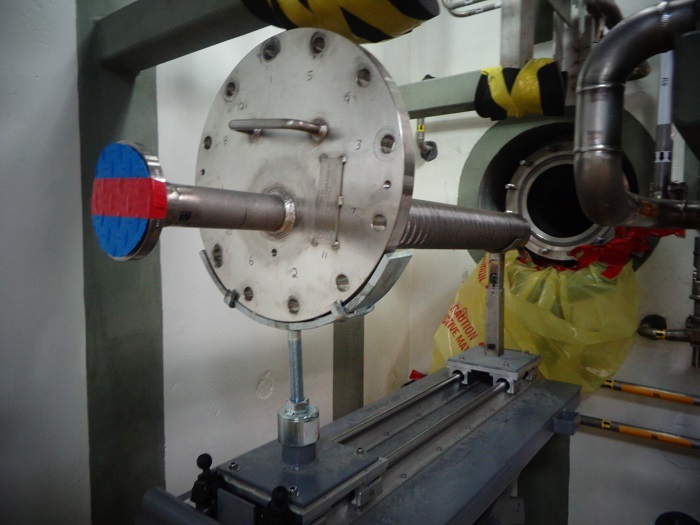 Savannah River Site liquid waste contractor Savannah River Mission Completion is partnering with engineering students from Claflin University to develop an improved method for removing and replacing the media inside the Salt Waste Processing Facility's strip effluent coalescer. Above, the media is shown on its transport cart.
AIKEN, S.C. – EM’s liquid waste contractor at Savannah River Site (SRS) has partnered with Claflin University to challenge the students to improve the method for removing and replacing radioactively contaminated equipment inside the Salt Waste Processing Facility (SWPF).
The partnership between contractor Savannah River Mission Completion (SRMC) and the Orangeburg, South Carolina, school further demonstrates the site’s dedication to supporting Historically Black Colleges and Universities (HBCUs), and helping strengthen the school’s science, technology, engineering, and mathematics (STEM) curriculum.
The project provides students the opportunity to improve the method for removing and replacing the radioactively contaminated device called the strip effluent coalescer within the SWPF solvent recovery system.
The coalescer combines small droplets of solvent to form larger droplets, enabling their separation from the high-activity salt waste. Any proposed improvements would be intended to use fewer resources and reduce the potential for radiation exposure to workers during removal, transport and replacement of the equipment.
The current process involves the hands-on use of a specially designed transport cart and crane.
SRMC President and Program Manager Dave Olson says this education outreach effort is designed to enable the students to put their training to use by generating new ideas and new methods.
“One of our goals is for the students to consider all possibilities for making our processes safer and better inside SWPF,” Olson said. “We want to motivate students to solve real-world technical issues.”
Karina Liles, Claflin’s interim chair of mathematics and computer science, believes the students will work hard to develop a safe and practical alternative. This capstone project provides the students with an opportunity to develop alternatives to current processes used inside the SRS liquid waste system.
“Our students are up to the task, ready to tackle both technical and operational challenges,” Liles said. “Throughout their STEM training, our focus has been hands-on, problem-based learning. This real-world challenge presents them with a wonderful opportunity for growth, and we are grateful for the opportunity provided by this partnership with Savannah River Mission Completion.”
The capstone program is a part of SRMC’s education outreach that introduces various SRS operations to students, helping them grow real-world skillsets while opening another pipeline of potential employees to support SRS work.
The STEM project began with the fall semester and continues until May 2023.
Radioactive liquid waste is generated at SRS as byproducts from the processing of nuclear materials for national defense, research, medical programs and outer space missions. Totaling about 34 million gallons, the waste is stored in the remaining 43 underground carbon-steel waste tanks grouped into two tank farms at SRS. The SRS liquid waste program consists of high-hazard operations, which include complex engineering, procurement, construction, waste treatment, grouting, and disposal to operationally close the waste tanks.
-Contributor: Jim Beasley
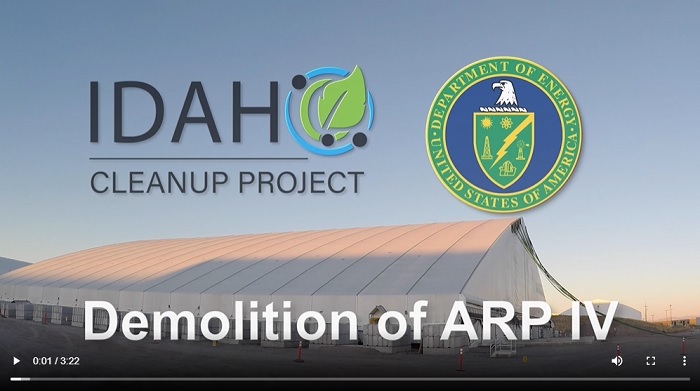 NEW VIDEO ALERT: Watch EM crews tear down a soft-sided structure that had been used in the retrieval of targeted buried waste at a Cold War-era landfill at the Idaho National Laboratory Site.
IDAHO FALLS, Idaho – EM crews recently demolished the first of the remaining structures over the Idaho National Laboratory (INL) Site’s Cold War-era landfill following the completion of targeted buried radioactive waste retrieval there earlier this year.
Workers with EM INL Site contractor Idaho Environmental Coalition (IEC) tore down the Accelerated Retrieval Project (ARP) IV facility at the Subsurface Disposal Area (SDA) after completing extensive decontamination work. They decontaminated its interior fabrics, equipment and structures, applied fixative to interior portions of the building to affix contamination in place, and added clean soil. The ARP IV structure and associated debris will be buried in place in the 97-acre landfill.
“We took our operations experience with the facility and applied it throughout facility deactivation,” said IEC Operations Manager Jerome Starks. “We learned something every day with this project.”
The fabric structure bound to steel framework was constructed in 2009 to retrieve targeted waste. Workers removed waste such as filters, sludges and reactive uranium material called roaster oxides, shipped there from the former Rocky Flats Plant near Denver, Colorado. Following completion of waste exhumation, ARP IV was used to store waste, equipment and soil.
The SDA, now a triangular-shaped section of the Radioactive Waste Management Complex (RWMC), was established in 1952 for shallow burial of contaminated INL Site waste. From 1954 to 1970, the landfill accepted Cold War weapons waste from sites in Colorado, New Mexico and other waste generators throughout the U.S.
In 2008, EM, the U.S. Environmental Protection Agency and state of Idaho agreed to exhume waste from a combined area of the SDA totaling 5.69 acres. That project was completed in March, about 18 months ahead of schedule. The effort helped protect the Snake River Plain Aquifer.
Engineers from RWMC used a computer model to demonstrate the proper number of structural components to be removed from ARP IV, sufficiently weakening the structure to a point where with the proper applied force, it could be pulled to the ground.
Work is progressing on deactivating ARP V. Crews will then shift to deactivate ARP II and III this winter. The remaining ARP structures at the SDA will be dropped in place and covered with soil.
-Contributor: Erik Simpson
 Brian Vance, manager of the EM Office of River Protection and Richland Operations Office, addresses the audience at the Volpentest HAMMER Federal Training Center’s 25th anniversary celebration. The facility began as a management-labor partnership focused on the safety and health of workers and emergency responders.
RICHLAND, Wash. – The Volpentest HAMMER Federal Training Center recently commemorated its 25th year of operation as EM’s premier hands-on health, safety and emergency response training center.
Managed by EM Richland Operations Office contractor Hanford Mission Integration Solutions, HAMMER stands for Hazardous Materials Management and Emergency Response. It began operations in 1997 as a centralized training location at the Hanford Site for emergency responders and cleanup workers and has expanded over the years to include support to the complex scope of work at Hanford and numerous national programs.
Brian Vance, manager of EM’s Office of River Protection and Richland Operations Office, recognized the facility’s valuable role in supporting the One Hanford cleanup mission during a special event last week celebrating the training center’s silver anniversary.
“HAMMER’s ongoing commitment to realistic, comprehensive training and constant improvement ensures our workforce has the resources and skills to do their jobs safely,” Vance said. “A demonstrated history of adaptability and meeting evolving needs with innovation and leadership means HAMMER will continue to play a key role at the Hanford Site.”
The facility covers an 88-acre campus featuring classrooms, specialized training areas and life-size props. Students are trained in a broad range of skills using hands-on activities and real-life scenarios. The center has logged more than 1 million student days — which is equivalent to the number of days students have been in class at the training center — and 72,000 course sessions in the last 25 years.
“Since the doors opened, our focus continues to be improving worker and emergency responder skills, safety and health through innovative training,” said Paul Vandervert, director of HAMMER. “Our staff, worker trainers and partners ensure we continue meeting the advancing needs of our customers.”
In addition to Hanford, HAMMER also provides expertise to local, regional, national and international programs focused on emergency response, energy restoration, law enforcement, military programs, border security and hazardous material transportation.
-Contributor: MaryAnne Wuennecke
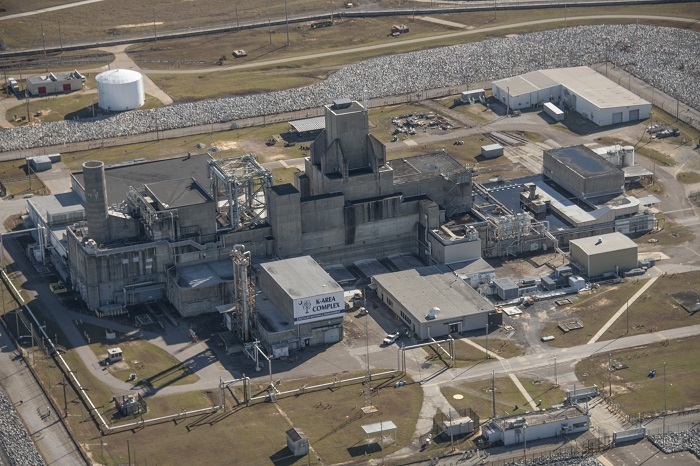 A view of the K Area at Savannah River Site, where employees began downblending plutonium in 2016.
AIKEN, S.C. – The Savannah River Site (SRS) exceeded its plutonium downblending goal for the fiscal year that ended Sept. 30 ahead of schedule as part of ongoing activities to remove the material from South Carolina.
“Exceeding our fiscal 2022 downblending goal ahead of schedule is a testament to our team’s commitment to safe, efficient and secure operations,” said K Area Facility Manager Lee Sims of Savannah River Nuclear Solutions (SRNS), the SRS management and operations contractor. “Much of our work in the past few years has been to introduce efficiencies and speed up our processing rates. This shows that our efforts are working.”
Plutonium materials shipped to K Area Complex at SRS are sealed inside a robust configuration of storage and shipping containers. The materials are stored in K Area until they are ready to be downblended.
Downblending is the method used at SRS for the disposition of surplus plutonium. Also referred to as dilute and dispose, downblending involves mixing the plutonium materials with an inert material called adulterant, producing a mixture that can eventually be safely disposed at a geologic repository.
This year, K Area personnel processed a variety of items, many of which provided unique challenges.
“K Area’s accomplishment is more impressive considering the nature of the packaging and risks associated with some of the materials we downblended this year,” Sims said. “Exceeding projected processing rates while handling a variety of materials for the first time builds a great foundation for the program moving forward.”
SRNS employees began downblending plutonium in K Area in 2016.
-Contributor: Lindsey MonBarren
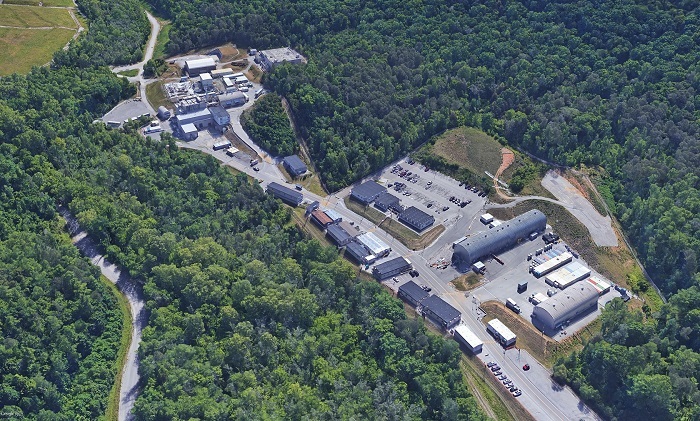 An aerial overview of the Transuranic Waste Processing Center in Oak Ridge. EM constructed the facility in 2003 to address a legacy stockpile of defense-related research waste.
OAK RIDGE, Tenn. – EM contractor UCOR last week assumed responsibility of the Transuranic Waste Processing Center (TWPC) and waste processing operations at Oak Ridge.
EM’s contract with the previous contractor operating the facility, North Wind Solutions, expired Oct. 26.
“We completed a pretty intensive 60-day transition, but now we have this great group of TWPC workers as part of the UCOR team,” said Maurice “Hoss” Brown, UCOR’s TWPC and transuranic (TRU) waste program manager. “An added benefit for UCOR is the wealth of knowledge that the TWPC workforce brings to the UCOR family.”
To date, employees at the TWPC have processed, repackaged and certified for disposal approximately 98% of Oak Ridge’s inventory of legacy TRU debris waste.
UCOR will complete work on the small amount of remaining TRU waste before eventually demolishing the facility.
The move transitions the TWPC work under the $8.3 billion Oak Ridge Reservation contract that began in May 2022 and continues for the next decade. It ensures appropriate resources and expertise are available to successfully address the remaining challenging TRU waste. Brown praised North Wind Solutions for its assistance in the seamless transition to UCOR.
“Transitioning the entire workforce of an operation like TWPC can be stressful and challenging,” Brown said. “North Wind Solutions was committed to performing a smooth transition and ensuring that the workers stayed informed during every step of the process.”
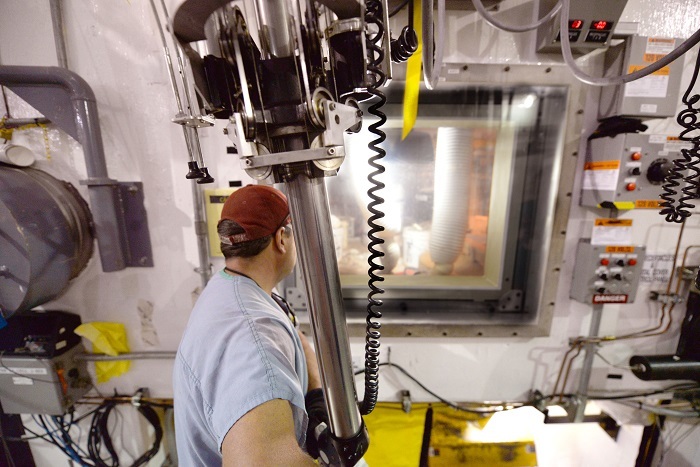 An operator at the Transuranic Waste Processing Center sorts waste using manipulators in a heavily shielded room known as a hot cell. Higher level radioactive waste called remoted-handled transuranic waste requires use of the special equipment to provide distance and shielding from the material.
EM constructed the TWPC in 2003 to address a legacy stockpile of defense-related research waste. TRU waste is artificially made, radioactive elements heavier than uranium on the periodic table.
Workers at the facility receive, process and package two forms of TRU waste: remote- and contact-handled waste. Remote-handled waste has higher radioactivity levels and must be processed using special equipment, while contact-handled waste has lower radioactivity levels and can be processed directly by employees.
After waste is processed at the facility, it is shipped to EM’s Waste Isolation Pilot Plant (WIPP) in New Mexico for safe, permanent disposal.
While TWPC employees have processed, repackaged and certified approximately 98% of Oak Ridge’s inventory of legacy TRU waste, the site is steadily working to ship its entire inventory of processed TRU waste to WIPP.
To date, Oak Ridge has shipped 83% of its contact-handled TRU waste and 70% of its remote-handled TRU waste to WIPP.
-Contributor: Susanne Dupes
|